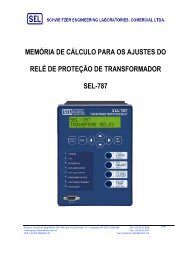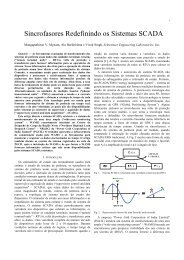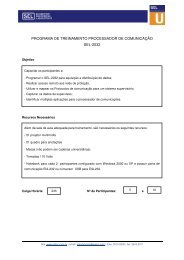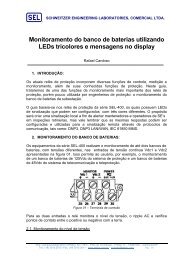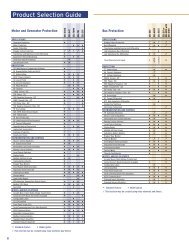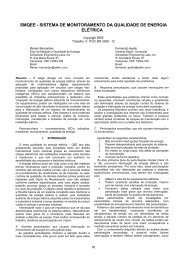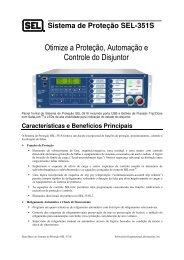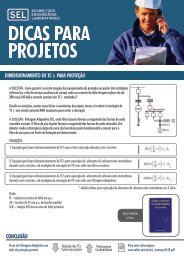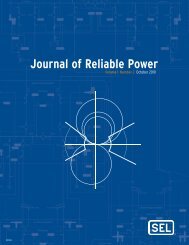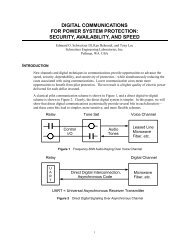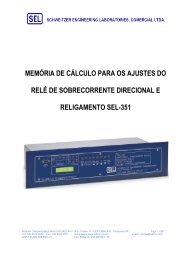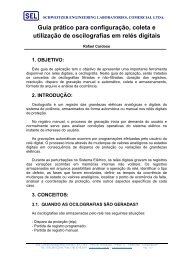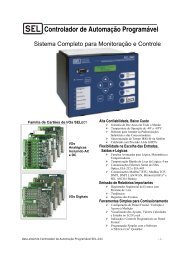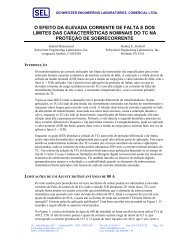Journal of Reliable Power - SEL
Journal of Reliable Power - SEL
Journal of Reliable Power - SEL
Create successful ePaper yourself
Turn your PDF publications into a flip-book with our unique Google optimized e-Paper software.
7<br />
For the purpose <strong>of</strong> implementing the directional element<br />
and the faulted phase selection for the high-speed part <strong>of</strong> the<br />
quadrilateral function, the algorithm described in [14] and [15]<br />
uses a function known as high-speed directional and fault type<br />
selection (HSD-FTS). It processes signals using half-cycle<br />
filters and superimposed quantities to provide the<br />
14 directional signals listed in Table I.<br />
TABLE I<br />
HIGH-SPEED DIRECTIONAL SIGNALS<br />
Signal<br />
HSD-AGF, HSD-AGR<br />
HSD-BGF, HSD-BGR<br />
HSD-CGF, HSD-CGR<br />
HSD-ABF, HSD-ABR<br />
HSD-BCF, HSD-BCR<br />
HSD-CAF, HSD-CAR<br />
HSD-ABCF, HSD-ABCR<br />
Fault Description<br />
Forward, reverse AG<br />
Forward, reverse BG<br />
Forward, reverse CG<br />
Forward, reverse AB<br />
Forward, reverse BC<br />
Forward, reverse CA<br />
Forward, reverse ABC<br />
Because the HSD-FTS signals are derived from<br />
incremental currents and voltages, they will be available only<br />
for 2 cycles following the inception <strong>of</strong> a fault. Consequently,<br />
the high-speed quadrilateral signals are available for the same<br />
interval <strong>of</strong> time following the detection <strong>of</strong> a fault.<br />
For the reactance element, the high-speed part <strong>of</strong> the<br />
quadrilateral characteristic implementation uses the same<br />
equations for the ground elements as the conventional<br />
counterpart uses with polarization based on negative- or zerosequence<br />
current. During a pole open, the polarization by the<br />
sequence current (negative or zero) is replaced by the<br />
incremental impedance loop current so that the ground<br />
elements remain operational for single-pole tripping<br />
applications.<br />
For the phase elements, polarization is based on the loopimpedance<br />
incremental current so that phase faults and singlepole<br />
tripping applications are automatically covered.<br />
For the two resistance blinder calculations, the equations<br />
are identical to their conventional counterpart so that the<br />
steady-state resistance reach will be identical.<br />
With the high-speed quadrilateral elements, reactance and<br />
resistance blinder calculations use a half-cycle filtering system<br />
to obtain fast operation.<br />
The logic for an A-phase-to-ground fault is presented in<br />
Fig. 13. Similar logic is used for the two other ground fault<br />
elements and the phase elements.<br />
Fig. 13.<br />
faults<br />
High-speed quadrilateral characteristic logic for A-phase-to-ground<br />
To illustrate the parallel operation <strong>of</strong> the high-speed and<br />
conventional quadrilateral elements, an A-phase-to-ground<br />
fault is staged at 33 percent <strong>of</strong> the line length <strong>of</strong> the highvoltage<br />
transmission line in the power network <strong>of</strong> Fig. 4. The<br />
impedance reach is set to 85 percent <strong>of</strong> ZL1. The fault is<br />
staged at 100 milliseconds <strong>of</strong> the EMTP (Electromagnetic<br />
Transients Program) simulation.<br />
Fig. 14 shows the distance to the fault calculations <strong>of</strong> the<br />
two reactance elements (high-speed and conventional) for Rf<br />
equal to 0 ohms. The high-speed element operates in<br />
12.5 milliseconds, and the conventional element operates in<br />
21 milliseconds.<br />
Distance to Fault (pu)<br />
Fig. 14. High-speed and conventional distance element calculations for a<br />
0-ohm, A-phase-to-ground fault at 33 percent <strong>of</strong> the line length<br />
Adaptive Phase and Ground Quadrilateral Distance Elements | 71



